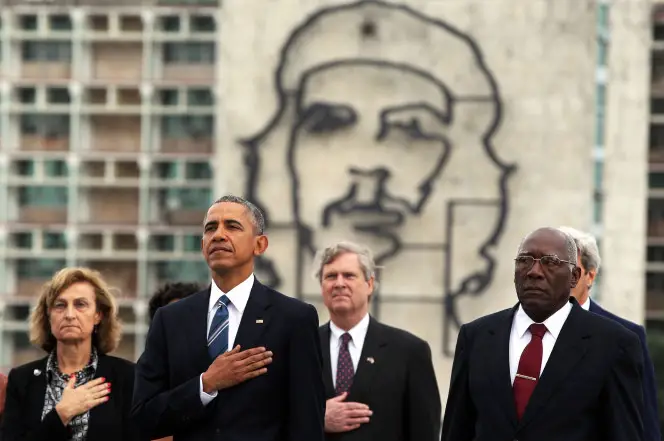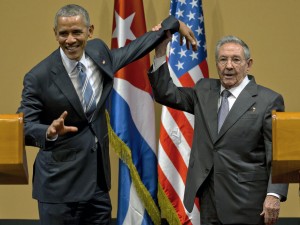Befriending Your Exes: A Lesson in Foreign Diplomacy
Waiting 60 years before speaking again is probably a little much though.
By Juliana Neves, Loyola University
As with any relationship, Cuba and America have a complicated history.
And put it kindly, that history has had its tense moments. Recently though, President Obama became the first sitting President to visit the country in 90 years, a massive step of reconciliation in restoring the countries’ diplomatic relationship.
And just as every America has its Cuba, every dating history has one troublesome ex. Whether you two graduated but then went to the same college, are broken up but still work together, moved in with each other and then split or just share the same group of friends, sometimes factors beyond your control mar even the cleanest of clean breaks.
For America and Cuba, geography has made moving on difficult. Ignoring a country that’s a mere 90-miles away from Miami has cost the US at least $30 billion in trade, leading to a pretty big elephant in the room. For anyone who still has to see their ex on a regular basis, the feeling is relatable.
The truth is there is a lot you can learn about dealing with your ex by looking at Obama’s handling of the Cuban embargo. It takes a lot of courage to suck up your pride and forget the past, but when there’s billions of dollars, medical breakthroughs and premium cigars at stake, extending the olive branch to your ex is worth it.
To understand the complicated history of American/Cuban relations though, you have to start at the beginning.
Cuba Flirts with Another Guy
During the latter half of the 20th century, communism terrified American politicians and citizens. It was undemocratic, unjust and un-American (ironically, Cubans’ love for baseball complicated this position). As America and the Soviet Union, the world’s two superpowers, began to draw ideological lines in the international sand, countries across the world had to pick sides.
Cuba was one of several Latin American countries that had already embraced Marxism, so when the Soviet Union offered economic support after Eisenhower imposed petroleum exports to Cuba, the Caribbean island happily sidled up to the Russians.
If Cuba and America had been in a relationship, Cuba’s embrace of communism and alignment with the Soviet Union would be like your girlfriend working with an attractive guy.
All she does is talk about the Soviet Union, but since you don’t work together all you can do is trust that she’s going to stay loyal to you. When you two get in arguments (and you do more and more), the Soviet Union is always there to listen to her.
America Goes Through Cuba’s Phone
In 1961, President Kennedy green-lighted the Bays of Pigs Invasion, a planned coup d’état that amounted to a failed US military invasion of Cuba.
Relations between the two countries had been deteriorating since Castro ousted the American-backed dictator Fulgencio Batista in 1959, but the Bay of Pigs marked America’s most naked act of aggression.
Basically, even if Cuba had been texting the Soviet Union, it was Cuba’s business. When American-trained Cubans tried and failed to topple Castro’s regime, it was like America got caught going through Cuba’s text messages.
Cuba had been acting weird, yes, but America still got caught red-handed with her phone. Even though she had been texting the Russians, America had no right to invade.
America and Cuba Split Up
Even though things were awkward, Cuba and America were still together until the October 1962 Cuban Missile Crisis.
The Crisis was essentially Cuba’s way of telling America that they were over, and that she was with the Soviet Union now.
America didn’t take it well, and after the split the US established the full-scale trade embargo that has stood for decades since.
Awkward Run-In
When you break up with someone, there always follows an awkward period in which you have to avoid seeing the other person at social events. You have to covertly ask your mutual friends who exactly is at the party or whether or not your ex has any plans tonight, because if you see each other it’ll not only be uncomfortable for the two of you, but for your friends as well.
When President Clinton expanded the embargo with the Helms-Burton Act in 1996, it was the diplomatic equivalent of running into your ex prematurely.
The bill extended the embargo’s application to include any country that traded with Cuba. As a result, the Helms-Burton basically said, “If you trade with them, you can’t trade with us.” The bill put everyone in an awkward situation, forcing countries to adopt America’s grudge or lose the country as a trading partner.
As a result for nearly 22 years the United Nations has condemned America’s embargo of Cuba, and a 2013 vote against the trade moratorium went 188-2, with only Israel supporting the US’s obstinacy. Understandably, the Helms-Burton marked one of the lowest points in the two country’s relationship.
America Slowly Reconnects Over Social Media
Until Obama, Cuban-American relations stayed pretty sour. By the time the 44th President of the United States took office, however, it was clear that both the government and the American people had grown sick of the embargo. With the goal of reconciliation, both political parties decided to begin the long process of moving forward.
After 50 years of bad blood though, neither country expected a simple “hug and make up” situation. You have to take these kinds of thing step by step.
In 2009 Obama lifted restrictions making it easier for Cuban-Americans, students and missionaries to travel, an analogous move to slowly reconnecting on social medial: liking a picture here, favoriting a tweet there, maybe even commenting on an Instagram post.
Unlike actually talking in person, Obama’s slight relaxation said, “I don’t hate you, but I’m not ready to see you yet.” Still, progress.
After slowly growing comfortable with social media friendship again, Obama decided America was ready to meet up with Cuba in person. The two countries are not the same hot-headed countries they were years ago; both have taken time to mature and deal with their own personal issues.
Still, since no President had visited America since 1928 though, it promised to be a little awkward.
First Meet-Up
And it was. Everyone was eager to see the two countries together, so it was important that they kept cordial and smiled. Even though both had some dirty laundry to air, they had to let bygones be bygones for the sake of their countries.
Obama and Raul Castro’s first handshake could not have been more awkward, but at least it’s a start. Although everyone (especially Obama and Castro) wanted to run out of the room to avoid the painful awkwardness, they both smiled and pushed forward.
After the handshake, the two decided to go to a baseball game together, just like old times. Cute right? Along with his family, Obama joined Castro to watch a match between the Tampa Bay Rays and the Cuban national team. The two even sat next to each other without a bodyguard or anything. Talk about improvement.
(NB: The Rays ended up winning the game. It’s nice to see that even when making amends, America always has to make sure everyone knows who is the best.)
Plans to Hang Out Again
Following the visit Castro called for an end to the embargo and Obama agreed. According to Cuban calculations the embargo has cost them nearly $1.1 trillion, and ending it would bring trade, tourism and modernization back to Cuba, hopefully giving it a much-needed facelift.
Even though both countries have made some mistakes, laying down the Cold War hammer might be the best for everyone. Who knows, maybe they’ll even get back together.















